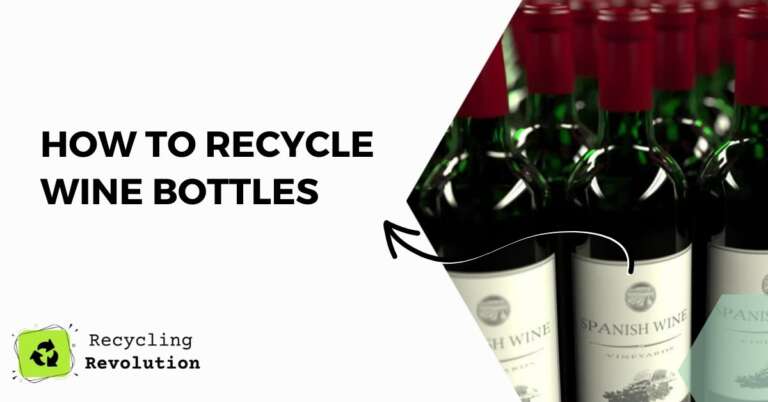You have just hosted a lively dinner party, or maybe you are just an enthusiastic connoisseur of fine wines. Either way, you are left with a number of empty wine bottles. As an experienced waste management enthusiast, I highly recommend rethinking your next move before these bottles end up in a landfill.
TL;DR: You can effectively recycle wine bottles by cleaning them, removing labels, and disposing of them in your local glass recycling facility. However, it might be worthwhile to consider repurposing them into DIY projects for a more sustainable and creative option.
Understanding the Environmental Impact
Why should you go through the effort of recycling or repurposing wine bottles? To answer that question, we must look at the environmental impact of not doing so.
As many in the recycling industry had alluded to, glass in landfills does not decompose. It takes around a million years for a glass bottle to decompose in the environment, which can cause severe environmental harm. According to the Environmental Protection Agency (EPA), recycling one ton of glass can save over 9 cubic yards of landfill space.
Is it bad to have glass in the environment?
Yes, improperly disposed glass, particularly in the form of litter or non-recycled waste, can indeed have 6 negative impacts on the environment.
Here are the main points:
- Persistence in Environment: Glass takes an estimated one million years to decompose in the environment. This means once it’s in a landfill, it will remain there indefinitely, taking up space and potentially contributing to overfilled landfills.
- Wildlife Harm: Glass litter can cause physical harm to wildlife. Animals may ingest small pieces of glass or be injured by larger fragments.
- Fire Risk: Discarded glass can act as a lens, concentrating sunlight and potentially starting fires in dry, wooded areas.
- Resource Depletion: New glass production involves the mining of raw materials, such as sand, limestone, and soda ash, leading to resource depletion and environmental degradation.
- Energy Intensive: The production of new glass from raw materials is energy-intensive, leading to high carbon emissions and contributing to global warming.
- Aesthetic Pollution: Glass litter can negatively impact the aesthetic value of natural environments, parks, beaches, and urban areas.
Preparing the Wine Bottles for Recycling
Recycling is not as simple as just throwing items into a bin. Proper preparation of the wine bottles can significantly increase the efficiency of recycling. Here are the steps I recommend:
- Rinse the Bottle: After consuming the wine, rinse the bottle with water to remove any remaining liquid.
- Remove Labels: Soak the bottle in warm soapy water. After a while, the label should peel off easily.
- Dry the Bottle: Allow the bottle to dry completely before putting it in the recycling bin.
Finding Your Local Recycling Facility
Once your bottles are ready, the next step is to find your local recycling facility. Not all areas accept glass in curbside recycling, so you might have to do a bit of research. A useful suggestion would be to use the online locator on the Glass Packaging Institute’s website, which lists glass recycling stations by state.
Repurposing Wine Bottles
Instead of recycling, it’s also possible to get in touch with your creative spark, and if you do any other of the things on this list I swear it will give you have kids then it’s something fun to do on a Sunday afternoon on a rainy day.
- Vases: Wine bottles, with their elegant shape, can make stunning vases. Simply clean them out, remove the labels, and they’re ready to hold fresh flowers.
- Candle Holders: As I mentioned earlier, wine bottles make for lovely candle holders. You can cut the bottom of the bottle off for large candles or just put a taper candle in the top for a simpler version.
- Lamps: With a little electrical know-how, a wine bottle can become the base for a beautiful, unique lamp.
- Planters: Wine bottles can be transformed into planters or terrariums. They’re especially good for plants like succulents and herbs.
- Bird Feeders: By attaching a feeding mechanism to the bottle, you can create a bird feeder. Fill it with birdseed, hang it up outside, and enjoy the wildlife it attracts.
- Serving Trays: If you cut a wine bottle lengthwise, it can be turned into a unique serving tray for snacks, cheese, or other hors d’oeuvres.
- Garden Borders: If you have enough wine bottles, they can be used to create unique garden borders. Just dig a trench and place the bottles neck down.
- Wind Chimes: Use the top half of the wine bottle to make beautiful wind chimes. They produce a lovely, mellow sound and add a personal touch to your garden or balcony.
- Holiday Decorations: Decorate your wine bottles with paint, glitter, or other materials to create holiday-themed decorations.
- Message Bottles: A cleaned and dried wine bottle can make a stylish and sentimental message or memory bottle. Great for gifting or memory keeping.
- Drinking Glasses: Cut and smooth the top of a wine bottle, and you have a unique drinking glass.
- Lanterns: With a little creativity, you can turn wine bottles into hanging lanterns, providing a warm, inviting glow to your patio or backyard.
The Science Behind Glass Recycling
We could talk about the science behind glass recycling, explaining how recycling centers process the glass and the energy-saving benefits. This could include:
- The Melting Process: When a recycling center receives the glass, they first sort it by color and then crush it into small pieces known as cullet. The cullet is then melted and molded into new products. This process is energy efficient as cullet melts at a lower temperature than raw materials.
- Energy Savings: According to a study by the Department of Energy (DOE), recycling glass uses 40% less energy than making it from raw materials. This not only saves on energy costs but also reduces greenhouse gas emissions.
The Lifecycle of a Wine Bottle
This would involve discussing the entire lifecycle of a wine bottle, from production to recycling or repurposing. Discussing this topic in detail could further emphasize the importance of recycling.
- Raw Materials: Talk about how wine bottles are made from silica (sand), soda ash, and limestone, which need to be mined from the earth, causing environmental degradation.
- Production Process: Discuss the energy-intensive process of heating these raw materials to 1700 degrees Celsius to create glass.
- Usage and Disposal: Highlight how often wine bottles are used just once before being discarded, and how this cycle is unsustainable.
- Repurposing or Recycling: Explain how giving the wine bottle a second life through either repurposing or recycling can interrupt this cycle, saving on energy and raw materials.
The Impact of Glass Production on Climate Change
Discuss the link between the production of new glass and climate change:
- Carbon Emissions: According to a report by the International Energy Agency, the production of glass is responsible for 1% of the world’s carbon emissions.
- Energy Usage: The Energy Information Administration states that for every ton of glass produced from raw materials, about 384 kilograms of carbon dioxide is released into the atmosphere.
By recycling glass, we can greatly reduce these emissions and our carbon footprint.
Don’t Forget Wine Bottle Corks
While you’re at it, don’t forget about the wine bottle corks. They are usually made of cork, a 100% natural, biodegradable, and renewable material. You can compost them or turn them into craft materials.
Conclusion
To conclude, learning how to recycle wine bottles is an essential step towards reducing our carbon footprint and becoming more sustainable. Beyond just recycling, repurposing wine bottles can lead to unique, homemade items that reduce the energy cost of recycling and give your home a unique touch.
Whether you choose to recycle or repurpose, remember: every step you take makes a significant difference in our collective effort to sustain our environment. So next time you pop open a bottle of your favourite vino, think of the potential your empty wine bottle has for a second life.
FAQ
Can I recycle wine bottles with the labels on?
While it is possible to recycle wine bottles with labels, I recommend removing them to increase the efficiency of the recycling process.
Is it necessary to rinse wine bottles before recycling them?
Yes, it is. It’s important to rinse out your bottles to ensure there is no leftover wine that could contaminate the recycling.
What can I do with wine bottle corks?
Wine bottle corks can be composted or turned into craft materials. They are fully biodegradable and renewable, so they are excellent for the environment.

